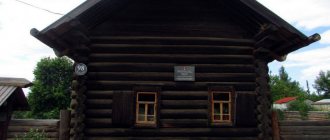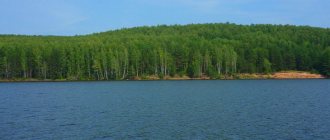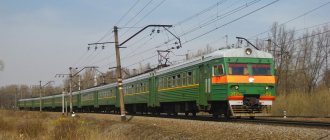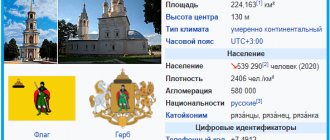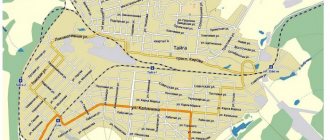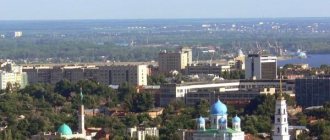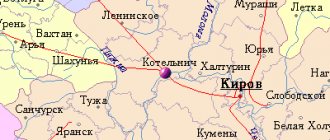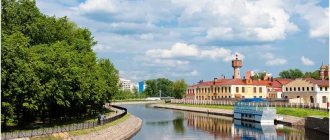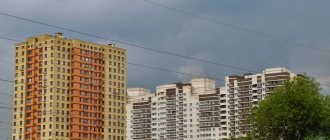Today Gubakha know in two roles - like a small town Perm region, famous for its ski resort and unusual art objects and, like a ghost town, from whose ambitions only a few crumbling, typical for the development of that time, 8-apartment two-story buildings, the ruins of the Palace of Culture and a couple of streets remain.
Author of the photo: Sergey Russkikh
A little about the history of Gubakha
The village of Gubakha arose on the Stroganov lands in 1755 after the discovery of iron ore deposits. The settlement was founded near the confluence of the Gubashka River and the Kosva River. It was from this river that it got its name.
The Gubakha pier was built near the mouth of Gubakha. The barges were built upstream of the Kosva (at the Nyarovskaya and Nyurovskaya piers), floated empty, and at the Gubakhinskaya pier they were loaded with iron ore and cast iron from the Kizelovsky plant, which was brought here on horseback. The barges were floated along the Kosva and Kama to the Chermoz and Polaznensky factories. True, there was little local ore, and it was of poor quality.
At the beginning of the 19th century, the first coal deposit in this area was found. This gave impetus to the development of the settlement. By that time, these lands belonged to the industrialists Lazarev and Vsevolod Vsevolozhsky. Since 1811, mined coal was sent by water to Lazarev’s Chermoz plant. The first adit later became the mine named after. 1st of May. After the construction of the railway line in 1879, coal production volumes increased sharply. Gubakha is located on the territory of the Kizelovsky coal basin.
In the first years of Soviet power, in 1924, the Kizelovskaya State District Power Plant was built in Gubakha - one of the first according to the GOELRO plan. In 1936, the first stage of the largest coke production enterprise in the country and the first in the Urals, the Gubakha Coke and Chemical Plant, was launched here.
In 1928, Gubakha received the status of an urban settlement, and in 1941, several workers’ settlements were united into the city of Gubakha. Verkhnyaya Gubakha became the center. All government agencies were concentrated here. Currently, the largest enterprises in the city of Gubakha are Gubakha Coke. The population of Gubakha is about 20 thousand people.
Museum of the city-forming enterprise "Metafrax"
They say you should definitely visit the Museum of the city-forming enterprise Metafrax. They talk about it, but there is no photo anywhere. According to information from the Internet, this is an innovative museum where you can see a light-dynamic model of the enterprise and a holographic screen that allows you to see the work of a virtual “chemical laboratory” in space. But it’s not clear how to get to the museum. But you can try calling in advance as there is no such address: Gubakha, 618250, . Phone: (34248) 4-08-98.
How Verkhnyaya Gubakha turned into a ghost town
When coal mining in the Kizelovsky coal basin began to decline in the 1960s, the population began to decline. Gubakha was helped to survive by Koksohimichesky. But due to harmful factory emissions, the old areas of the city had to be resettled, primarily the former administrative center of Verkhnyaya Gubakha. Local residents were resettled to the so-called New Gubakha.
Officially, this closed settlement of coal miners was called Verkhnyaya Gubakha, but the unofficial name Staraya Gubakha is also common. The houses stood on the high right bank of the Kosva River. People left this place, and on the mountainside, in the historical center of Gubakha, ruins remained. True, many of them were dismantled by local residents for building materials.
Although people were resettled, summer cottages spontaneously appeared nearby. Their owners are not at all embarrassed by environmental problems.
origin of name
The official version explaining the origin of such an unusual name for the city says: the word “Gubakha” was formed from an anthroponym. It means “man with thick lips.”
Interesting fact! There are also alternative versions of the words that gave the name to the settlement, from an edible mushroom and a twisted tree to a wooden platform for building barges and a piece of land protruding into a body of water.
In total, Ural local historians counted twelve possible options for the origin of the name. Which one is closest to the truth is unknown.
What to see in Staraya Gubakha
The ghost town still has streets paved with slag paving stones. On the sides there are overgrown ruins of former residential two-story buildings, as well as administrative and public buildings. Before the closure of the village, there were buildings of the city executive committee, the city committee of the party and the Komsomol, a school, a stadium, a children's clinic, a clinic, a fire department, the Palace of Working Youth, a department store, and a mine management building. Kalinina. Only the foundations of many buildings remain. After all, many decades have passed since the closure of the settlement.
Part of the ruins of the Palace of Working Youth with a characteristic semicircular balcony has been preserved (in some sources it is mistakenly called the building of the NKVD). It was built of red brick, had balconies and arched windows. At various times, the administration of the Andreevugol trust, a dormitory for workers and specialists, and school No. 1 were located here (during the renovation of the main school building). In 1970, the building was given over to a sports knitwear factory.
a cinema “Shakhtar” in Verkhnyaya Gubakha with 330 seats. A department store and a pastry shop operated in the same building.
Among the industrial enterprises in Verkhnyaya Gubakha there were a motor transport enterprise, a brick factory, a lime quarry, a reinforced concrete plant, a workshop for the production of cinder blocks, and a furniture factory. When the mines were working, there were three horse yards: mines named after. Kalinina, ORSA Gubakhaugol and one more. Horses were used, among other things, for transporting building materials, food, plowing gardens, etc.
In 1947-48 on the street. On Oktyabrskaya they created a park and planted trees and shrubs. Later it was named a public garden in honor of the 50th anniversary of the Komsomol . Local residents loved to relax here.
Below the square there was the Shakhtar stadium with a playing field and stands. There were cafes and pavilions nearby. In the summer they played football and held competitions, and in the winter they filled the skating rink. On New Year's Eve they put up a Christmas tree here.
city hospital No. 1 in Verkhnyaya Gubakha , built in 1949 and designed for 114 beds. The building was decorated with stucco. The hospital had X-ray and physiotherapy rooms with modern equipment for that time, two operating rooms, maternity, surgical, therapeutic, gynecological, and children's departments.
The real decoration of Upper Gubakha is the Palace of Culture of the Mine named after. Kalinina . The building was built back in the 1930s in the Stalinist Empire style. It was erected on a hill. A beautiful grand staircase with a balustrade led to the entrance. The building was decorated with monumental columns. At the entrance there were sculptures of miners with jackhammers. The auditorium was designed for 500 seats. The library was located on the second floor. Children's clubs worked here: choral, dance, drama, and brass bands. The Kizelovsky Drama Theater performed on stage, and sometimes there were even concerts by metropolitan artists.
Of all the buildings in the ghost town, the building of the Palace of Culture is the best preserved and is its informal symbol.
To the side of the main street, the ruins of the Central Experimental Electrical Workshops (CEMM) of the Andreevugol trust . They were created in 1942 on the basis of the mechanical workshops of the mine named after. Kalinina. Since 1959, they became an experimental site for the Permgiprogormash Institute. New machines and mechanisms for coal and potash mines were created here. Many of them were presented at VDNH in Moscow.
Nearby there is a monument to the mass grave of the victims of the Civil War - M. Demenev and M. Potapov.
Although most of the buildings have been destroyed over the past decades, the ghost town of Staraya Gubakha is still interesting to walk around. The best time to visit is the end of June, when the ghost town comes to life again thanks to the Gubakha ALIVE . On this day, historical reconstructions, a fair, sports competitions are organized on the territory of Upper Gubakha, excursions are held, and local talents perform here. Guests of the festival find themselves in the 1940-60s. Former local residents, their children and grandchildren come here.
They tried to turn Upper Gubakha into a brand; they even developed a corporate identity and produced souvenirs. Along with the village of Yubileiny, Verkhnyaya Gubakha is one of the most famous and popular ghost towns in the Perm region.
Attractions in the surrounding area
The places around Gubakha are very beautiful! If you go behind the recreation center, you will come to picturesque rocks from which a beautiful view opens. At the base of the rocks there is a grotto called Dvortsov.
In other rocks north of Verkhnyaya Gubakha there is the Mariinskaya Cave, 1000 meters long, as well as several other caves.
To the west of the former village, near the railway, there are the ruins of the former mine named after. Kalinina . In the past, there was even a cable car here, which brought coal from the other side of the Kosva.
Abandoned Gubakha mines and contaminated mine waters emerging from them to the surface have a negative impact on the environment. In fact, mine water is a weak solution of sulfuric acid and poses a great danger to all living things. If upstream the water in the Kosva River is the purest, then from Gubakha it becomes extremely dirty. Flowing mine waters form small waterfalls in places.
If you go even further along the railway towards the highway, you will come across a rock with numerous fossils - the Gubakha geological section .
On the other side, also not far from the railway, among the thickets of trees you can find a vaucluse (water hole) of an underground river . A picturesque lake has formed here. This place is located in the valley of the Gubashka River. As karst researcher Igor Lavrov told me, the water in this source comes from the Oka-Serpukhov aquifer, from the limestones that make up the left side of the Mariinsky Log. This is the discharge point of the underground river Mariinsky Log. Several caves are known in this limestone massif, including the Mariinskaya Cave, which is about 1 km long.
Higher up, the ground channel almost dries out in summer. Below, the river flows into the Kosva River. At the site of the vaucluse (emergence) of the river, a small but deep lake with a water color from bluish-green to whitish formed.
I suggest you admire this place in a short video.
the source Yellow River comes to the surface . According to Igor Lavrov, the Yellow River is connected with the limestones of the Kremensky strata, with the groundwater of the valley of the Gubashka River . This source has an underwater continuation, buried by blocks of limestone. To the right and higher up the slope there is a cave of the same name, which in the spring also turns into a spring.
As G.A. writes Maksimovich and K.A. Gorbunov in the book “Karst of the Perm Region” (Perm, 1958) the Gubashka River flows underground for 16 km out of 30. Now these Vaucluses are clean and not polluted by mine waters. During our travels around Gubakha, we repeatedly collected water from this source.
Verkhnyaya Gubakha stands on the right bank of the Kosva River. And opposite, on the left bank, rises Mount Krestovaya with its popular winter ski resort. A few years ago, the art object “Happiness in the Mountains” was installed here. At the top of the mountain there are several beautiful rock outcrops.
Upstream the Kosva River, on its left bank, stands the majestic Rook Stone . A suspension bridge across the river was built nearby. There are several caves in Ladeyny Kamen, and nearby there is Ladeyny Log with numerous karst forms. The most interesting and famous of them are the Russian cave and the large karst sinkhole.
In 2022, some scenes of the film based on the novel by the Ural writer Alexei Ivanov “The Heart of Parma” were filmed in Gubakha. a wooden fortress was built on the edge of Gubakha, behind the cemetery on the high right bank of the Kosva .
Even higher upstream of the Kosva, on its right bank, you can find the Right Boot cave . In spring or after heavy rains, an impressive waterfall forms at its entrance.
Useful tips for tourists
The city welcomes guests in both warm and cold seasons. Here you can always find activities to your liking. But it makes sense to come here only for active recreation: alpine skiing, mountain walks, descents into caves.
The main tourist destination in this area is the ski resort. There are trails for independent skiing here. But you can also enroll in a ski school. We accept both children and adults for group and individual lessons.
The weather in the Perm region is replete with precipitation. Therefore, in spring or autumn you cannot do without a raincoat and waterproof shoes. To explore the surroundings of Gubakha, it is worth taking with you comfortable shoes with non-slip soles.
In mountainous areas, the wind is felt sharply, clothing should protect against its gusts. In winter, there are no snowdrifts on the main tourist routes; the paths are well-trodden.
You can stay in Gubakha in one of several guest houses. Not far from the city, in the village of Ugleuralsky, there is the Metafrax sanatorium, which offers many health treatments. The dispensary is equipped with water and mud baths.
How to get to Upper (Old) Gubakha?
From the city of Perm you need to drive along the Solikamsky tract, in the Polazny area turn towards the city of Chusovoy. After passing through Chusovoy, follow the highway in the direction of Berezniki and Solikamsk. Having reached Gubakha, before the bridge over Kosva, take the secondary road that runs along the left bank of the river. Moving along the main road, drive past the ski slope, cross the road bridge over the river and turn right after it. The road runs along the railway, and after a few hundred meters there will be a bus stop “Verkhnyaya Gubakha”. If you leave your car here and cross the railroad tracks, you will find yourself in a ghost town.
From the city of Yekaterinburg by car you need to go along the Serovsky tract, turn to Kachkanar, then to Gornozavodsk and go towards the city of Chusovoy. A little before reaching Chusovoy, turn to Berezniki (Solikamsk), and then follow the route described above. The map below will help you navigate.
You can also get to Gubakha by public transport: by bus, train or commuter train, and then by city bus or on foot to Verkhnyaya Gubakha.
GPS coordinates of the ghost town of Old (Upper) Gubakha: N 58° 52.323´; E 57° 36.181´ (or 58.87205°, 57.603017°).
Distance from Perm – 220 km, from Yekaterinburg – 410 km.
Pavel Raspopov UraloVed.ru
Reviews
Irina Smelkovskaya, 29 years old, Tchaikovsky
“We first came to Gubakha at the invitation of friends living in the nearby village of Shirokovskoye. But I would like to talk separately about the natural monument Stone Town. You can get to it from Gubakha in literally 15–20 minutes. This is a system of crevices in the rock mass, which somehow reminded me of city avenues and streets. I came here in the fall, so there was mud crunching under my feet, there was light rain, from which there was nowhere to hide, but the views were simply fabulous. I especially remember the stones with the names Big and Small Turtle.”
